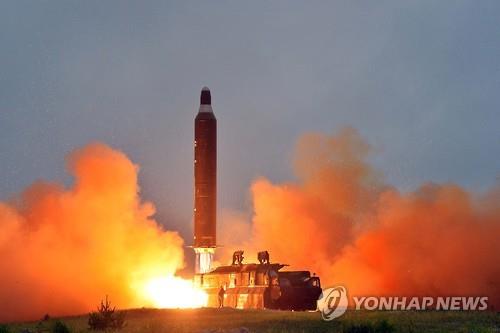- California Assembly OKs highest minimum wage in nation
- S. Korea unveils first graphic cigarette warnings
- US joins with South Korea, Japan in bid to deter North Korea
- LPGA golfer Chun In-gee finally back in action
- S. Korea won’t be top seed in final World Cup qualification round
- US men’s soccer misses 2nd straight Olympics
- US back on track in qualifying with 4-0 win over Guatemala
- High-intensity workout injuries spawn cottage industry
- CDC expands range of Zika mosquitoes into parts of Northeast
- Who knew? ‘The Walking Dead’ is helping families connect
U.S. confirms N. Korea’s Musudan missile reaches space
WASHINGTON/SEOUL June 28 (Yonhap) — North Korea’s Musudan intermediate-range ballistic missile reached space and then re-entered Earth’s atmosphere in its sixth test attempt last week, a U.S. defense official confirmed Monday, saying the launch would be a success if Pyongyang had designed the test that way.
“We saw the missile launch. We saw it go up into space and come back down 250 miles away in the Sea of Japan. If that was their intent, then it was a success. But you’d have to ask them,” Pentagon spokesman Capt. Jeff Davis told reporters.
“This might have been, but it’s really their test and they knew what the parameters are and only they could say if it met those objectives or not,” he said.
It was believed to be the first time the U.S. has confirmed the performance of the North’s missile launch.
A day after Wednesday’s test of the missile believed to be capable of reaching the U.S. territory of Guam, the North claimed success, saying the missile entered space before successfully re-entering the atmosphere and landing in targeted waters about 400 kilometers away.

This photo from North Korea’s Rodong Sinmun, the ruling party newspaper, on June 23, 2016, shows the launch of the Musudan IRBM. (For Use Only in the Republic of Korea. No Redistribution) (Yonhap)
The launch marks important progress in the North’s missile program as re-entry technology has been considered one of the hardest obstacles the North must overcome before developing a nuclear-tipped intercontinental ballistic missile.
The latest test was the North’s sixth attempt to test the missile in about two months beginning April 15. All but the sixth launch failed, with the missile exploding in midair or on a mobile launcher, or crashing seconds after launch. “From our perspective… it reminds us of the importance of our alliances with Japan and the Republic of Korea to ensure that we can adequately work together to defend against all kinds of missiles, not just these with an intermediate range, but the ones that could potentially threaten our homeland here,” Davis said.
The test also underscored the “reason why we need to continue to put pressure on North Korea to abide by its U.N. Security Council resolutions, its obligations under U.N. Security Council resolutions, and to be a good neighbor in the region, which they’re clearly not being,” he said.
The official also stressed the U.S. is ready to counter the threats as it always tries to outpace them.
“Long before they ever tested this system, we were already doing things to make sure we are postured in the region. We have Aegis cooperation we do with Japan. We have TPY-2 radars in Japan. Long before they ever paraded out a KN-08, we had already put in ground-based interceptors in Alaska and Hawaii. We’ve got THAAD in Guam. We have things that we’re doing. We’re making sure we’re outpacing this threat constantly,” he said.
Commenting on the Pentagon assessment, however, South Korea’s defense ministry spokesman Moon Sang-gyun said the North’s latest missile launch does not mean the North has secured re-entry technology.
Asked whether the fired missile or its payload has re-entered Earth’s atmosphere without damage, Moon said a joint analysis between South Korea and the U.S. is still underway to verify the matter.












dog walking on
June 29, 2016 at 5:50 AM
AMC Theatres – Get movie times, view trailers, buy …
what is atmospheric
July 1, 2016 at 12:31 AM
Raid Expedition: Calling Phantasm :: Quests :: …